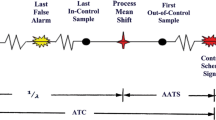Abstract
The control chart is one of the most powerful techniques in statistical process control (SPC) to monitor processes and ensure quality. The sample size n plays a critical role in the overall performance of any control chart. This article studies the effect of n on the performance of Shewhart control charts, which have traditionally been used for monitoring both the mean and variance of a variable (e.g., the diameter of a shaft and the temperature of a surface). The study is conducted under different combinations of false alarm rate and process shift. The detection speed of the Shewhart charts is evaluated in terms of average extra quadratic loss (AEQL) which is a measure of the overall performance. It is found that n = 2 is the best sample size of the Shewhart \( \overset{\_}{\boldsymbol{X}}\&\boldsymbol{R} \) and \( \overset{\_}{\boldsymbol{X}}\&\boldsymbol{S} \) charts. The comparative study reveals that the \( \overset{\_}{\boldsymbol{X}}\&\boldsymbol{R} \) and \( \overset{\_}{\boldsymbol{X}}\&\boldsymbol{S} \) charts with n = 2 outperform the \( \overset{\_}{\boldsymbol{X}}\&\boldsymbol{R} \) and \( \overset{\_}{\boldsymbol{X}}\&\boldsymbol{S} \) charts with n ≥ 4 by at least 9 and 7 %, respectively, in terms of AEQL. These results contradict the common knowledge in SPC niche that n between 4 and 6 is usually recommended for the \( \overset{\_}{\boldsymbol{X}}\&\boldsymbol{R} \) and \( \overset{\_}{\boldsymbol{X}}\&\boldsymbol{S} \) charts.
Similar content being viewed by others
References
Montgomery DC (2013) Introduction to statistical quality control. John Wiley & Sons, New York
Haridy S, Gouda SA, Wu Z (2011) An integrated framework of statistical process control and design of experiments for optimizing wire electrochemical turning process. Int J Adv Manuf Technol 53(1–4):191–207
Castagliola P, Celano G, Fichera S, Nenes G (2013) The variable sample size t control chart for monitoring short production runs. Int J Adv Manuf Technol 66(9–12):1353–1366
Azam M, Aslam M, Jun C-H (2015) Designing of a hybrid exponentially weighted moving average control chart using repetitive sampling. Int J Adv Manuf Technol 77(9–12):1927–1933
Costa AF, De Magalhaes MS (2007) An adaptive chart for monitoring the process mean and variance. Qual Reliab Eng Int 23(7):821–831
Reynolds MR, Stoumbos ZG (1998) The SPRT chart for monitoring a proportion. IIE Trans 30(6):545–561
Domangue R, Patch SC (1991) Some omnibus exponentially weighted moving average statistical process monitoring schemes. Technometrics 33(3):299–313
Wu Z, Tian Y (2005) Weighted-loss-function CUSUM chart for monitoring mean and variance of a production process. Int J Prod Res 43(14):3027–3044
Wu Z, Yang M, Khoo MB, Yu F-J (2010) Optimization designs and performance comparison of two CUSUM schemes for monitoring process shifts in mean and variance. Eur J Oper Res 205(1):136–150
Costa AF, de Magalhães MS, Epprecht EK (2009) Monitoring the process mean and variance using a synthetic control chart with two-stage testing. Int J Prod Res 47(18):5067–5086
Arnold JC, Reynolds M (2001) CUSUM control charts with variable sample sizes and sampling intervals. J Qual Technol 33(1):66–81
Luo H, Wu Z (2002) Optimal np control charts with variable sample sizes or variable sampling intervals. Economic Quality Control 17(1):39–61
Celano G, Costa A, Fichera S (2006) Statistical design of variable sample size and sampling interval\bar X control charts with run rulescontrol charts with run rules. Int J Adv Manuf Technol 28(9–10):966–977
Kaya I (2009) A genetic algorithm approach to determine the sample size for attribute control charts. Inf Sci 179(10):1552–1566
Wu Z, Yang M, Khoo MB, Castagliola P (2011) What are the best sample sizes for the Xbar and CUSUM charts? Int J Prod Econ 131(2):650–662
Haridy S, Wu Z, Lee KM, Bhuiyan N (2013) Optimal average sample number of the SPRT chart for monitoring fraction nonconforming. Eur J Oper Res 229(2):411–421
Reynolds MR, Arnold JC (2001) EWMA control charts with variable sample sizes and variable sampling intervals. IIE Trans 33(6):511–530
Lee P-H, Chang Y-C, Torng C-C (2012) A design of S control charts with a combined double sampling and variable sampling interval scheme. Communications in Statistics-Theory and Methods 41(1):153–165
Reynolds MR Jr, Stoumbos ZG (2004) Control charts and the efficient allocation of sampling resources. Technometrics 46(2):200–214
Wu Z, Xie M, Tian Y (2002) Optimization design of the X & S charts for monitoring process capability. J Manuf Syst 21(2):83–92
Montgomery DC, Woodall W (1999) Research issues and ideas in statistical process control. J Qual Technol 31(4):376–387
Reynolds MR, Amin RW, Arnold JC (1990) CUSUM charts with variable sampling intervals. Technometrics 32(4):371–384
Khoo MB, Tan EK, Chong ZL, Haridy S (2015) Side-sensitive group runs double sampling (SSGRDS) chart for detecting mean shifts. International Journal of Production Research (ahead-of-print):1–19
Sparks RS (2000) CUSUM charts for signalling varying location shifts. J Qual Technol 32(2):157
Ou Y, Wu Z, Tsung F (2012) A comparison study of effectiveness and robustness of control charts for monitoring process mean. Int J Prod Econ 135(1):479–490
Taguchi G, Wu Y (1980) Introduction to off-line quality control. Central Japan Quality Control Association, Nagoya, pp. 49–67
Shamsuzzaman M, Khoo M, Haridy S, Alsyouf I (2014) An optimization design of the 3-EWMA scheme for monitoring mean shifts. Int J Adv Manuf Technol 74(5–8):1061–1076
Haridy S, Wu Z, Abhary K, Castagliola P, Shamsuzzaman M (2014) Development of a multiattribute synthetic-np chart. J Stat Comput Simul 84(9):1884–1903
Author information
Authors and Affiliations
Corresponding author
Rights and permissions
About this article
Cite this article
Haridy, S., Maged, A., Kaytbay, S. et al. Effect of sample size on the performance of Shewhart control charts. Int J Adv Manuf Technol 90, 1177–1185 (2017). https://doi.org/10.1007/s00170-016-9412-8
Received:
Accepted:
Published:
Issue Date:
DOI: https://doi.org/10.1007/s00170-016-9412-8



